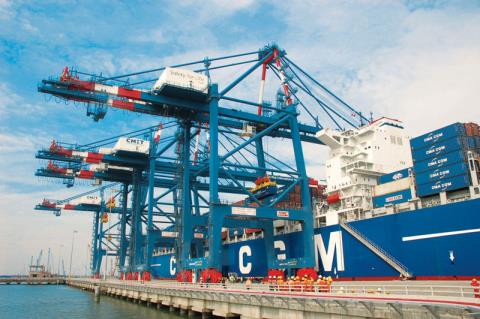Vietnam loses $2.4 billion as deep-water port has insufficient infrastructure
 |
| Vietnam has spent bit money to build ports |
Ho Kim Lan, secretary general of the Vietnam Port Association (VPA), said 80 percent of container imports and exports still have to go through small ports and vessels.
“It is just like the story about a man who drives his private car and another man who travels on the bus. It is less costly to travel on a bus. If goods can be shipped with large vessels, goods owners can save $200-300 per container compared with small vessels,” he said.With the current import/export turnover, Vietnamese goods owners bear a loss of $2.4 billion every year because they cannot use a deep-water port.
Vietnam has many small ports, but lacks spaces for large ships, which is believed to be a major reason hindering the development of the maritime shipping industry.
Vietnam has one modern deep-water port complex, CMIT (Cai Mep International Terminal), the only one in Vietnam which can receive vessels with tonnage of 18,000 TEUs.
However, vessels refuse to enter CMIT despite its great advantages, and prefer to have goods handled at Cat Lai Port in HCMC.
A report found that in 2012, the average used capacity of the seven ports of CMIT was 15-20 percent of the designed capacity.
Lan said Vietnam had reserved room for a deep-water port complex, but had not reserved space for infrastructure items to serve ships going in and out.
“The problem is the lack of comprehensive development of items needed for a port complex. Since there is no transport network that connects the complex, vessels still have to use Cat Lai Port,” he said.
The low capacity of CMIT is a big waste for Vietnam, because only Cai Mep – Thi Vai area and possibly Lach Huyen (Hai Phong City) in the future have favorable natural conditions to build deep-water ports.
“We have been trying every possible way to attract goods to CMIT, but the efforts have brought very modest results. This is attributed to poor infrastructure connections and bad support services for deep-water ports,” Lan said.
The World Bank recently released a warning about the development of too many seaports and airports and about their low efficiency.
Vietnam now has up to 320 ports. And though the ports offer very low service fees, they still find it hard to attract international clients.
A survey found that Vietnam charges $32 for one TEU, while the fee is $55 in Thailand, $76 in China and $117 in Singapore.

